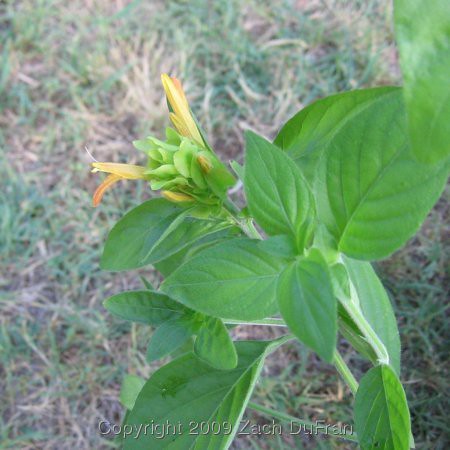There are two tropical plants that go by the name of shrimp plant and are fairly easy to find. They're still considered sort of oddities, because of their unique bloomage. The two most popular are the Pink or Red Shrimp plant (
Justicia brandegeana) and the Yellow Shrimp plant or Lollipop plant (
Pachystachys lutea). It is so surprising to me that these two very similar plants do not share the same genus, but their genera are in the same family (Acanthaceae). When I was in Hawaii, there were yellow shrimp plants that were growing in hedges about 6 feet tall and about 8 feet wide! Very cool.
 |
| Hedge of Yellow Shrimp plants (Pachystachys lutea) at the hotel Napili Surf in Maui, Hawaii. |
As you can see, the Yellow Shrimp plants are more woody than the other shrimp plants. Even my small Yellow Shrimp plant (pictured below) is much woodier than my other shrimp plants of similar size. So, there are noticeable differences between the shrimp plants of these two different genera. Also, the leaves of the Yellow Shrimp plant are darker green, more glossy and more deeply veined.
 |
| Red Shrimp plant (Justicia brandegeana) blooms |
I have started a collection of shrimp plants, including five different varieties. All of them are from the
Justicia genus, except for the yellow shrimp plant. The
Justicia genus has several other cool tropical plants that can be container grown, such as the Brazilian Plume (
J. carnea), the Firecracker Plant (
J. spicigera), and Purple Shrimp Plant (
J. scheidweileri). Each of these plants differs pretty substantially from the other Shrimp plants that are in my collection.
 |
| My Shrimp Plant Collection. The pot on the left has Yellow (Pachystachys lutea). The pot on the right has all of my others: Red (Justicia brandegeana), Fruit Cocktail (J. brandegeana 'Fruit Cocktail'), Mexican Plume (J. fulvicoma), and White (J. betonica). The tall stem on the right is the White. |
One species that I have in my collection came from Hawaii, where I saw it growing in the wild, not far from the beach. It is the White Shrimp plant, also called the Squirrel's Tail (
Justicia betonica). This is probably the rarest of my shrimp plants, in terms of being raised in a container. The plants that I saw blooming in Hawaii were the only thing growing in a large shady area and all of the blooming tops were about 4 to 5 feet tall. I'm not sure how likely mine is to bloom in a crowded container, but the plant has been growing well over the past two months.
 |
| White Shrimp plant or Squirrel's Tail (Justicia betonica) growing in Maui, Hawaii. |
Another cool shrimp plant in my collection is the Mexican Plume (
J. fulvicoma), which I got from the Bustani Plant Farm. I just noticed yesterday that it has begun to bloom. The usual bracts that are so recognizable among shrimp plants are green for this plant and the actual tubular flowers that come out of the bracts are brightly colored in orange and yellow.
 |
| Mexican Plume (Justicia fulvicoma) bloom - one of my favorites |
The last of my five varieties is a cultivar called "Fruit Cocktail" (
J. brandegeana 'Fruit Cocktail'). This one has more yellow-green bracts, with pink tubular flowers. Mine was blooming when I purchased it, but I forgot to get a picture and now it is out of bloom.
Soon I'll have to add a Purple Shrimp Plant. They are a very fun plant to collect and really easy to care for during our long, hot summers. They enjoy being in full sun, as long as they are watered about once a week. The White Shrimp Plant is more sensitive to light and would prefer a shadier location. I have my pot of four different shrimp plants in a semi-shady location and have to keep an eye on the leaves of the White Shrimp plant, which wilt more easily.
Which shrimp plants do you grow?





I always learn something new from your posts Zach! Thank you!
ReplyDeleteHmmm...like your collection. I assume they are tropicals?
ReplyDeleteHowdy, and congrats on your collection of 'shrimp plants.' I have a nerdy obsessive fascination with the Acanthacea family to which they belong and have made a nice landscape utilizing them, amongst others, here in California. You can see my plants on Flickr: Wilting_In_Sac. I was sure you were aware your 7-8 zone in OK is death to all of those plants. They do all seed easily when hummingbirds are around to fertilize them, and can be easily germinated to repropagate, but otherwise need overwintering indoors. As Central and South American natives, I have discovered they tend to react poorly to the broad ranges in temps we see in North America as winter approaches and often regret being shifted indoors to stable temps with low humidity and light and curl up and die. If they don't, they often become infested with whiteflies or scales, so I rec systemic feeding if you take them in. Justicia scheidweileri is especially tender and sensitive to low humidity and direct sunlight, but with time becomes a respectably woody shrub with impressive explosions of color. It is more commonly known as Porphyrocoma Pohliana, or red pine cone. As far as J. Brandegeana is concerned, you have one of the mutant forms that produces upright facing bract towers; some with white flowers and some with pink. The standard 'shrimp plant' bract flops over in an arc. There are yellow and white versions of Bradegeana, Lutea and Alba, and you have the 'fruit cocktail' and "Mexican Plume" Fulvicoma. J. Carnea is a great plant and a variant has purple leaf undersides... there is also J. Aurea and Alba, more tender gold and white pluming versions. J Spicigera is AKA 'Mexican Honeysuckle' and flowers vary from orange to red. I see you have J. Rizzini on your want list...if you have not yet found it I can point you to a vendor. They are all pretty aggressive bloomers and heavy feeders so I rec fertilizing often especially in container. I usually do so weekly during the growing season. Other Mexican and S. American Acanths to play with include the firespike: Odonotonema, the Brazilian Cloak: Megaskespasma, and the amazing tropical Aphelandras. Acanths have amazing sisters all around the world and I recommend looking into some of the S.African species that have come available, such as the Ruttyas, Ruspolias, & Metarungia. Also the Indian/Asian Strobilanthes sp., Mackaya Bella, Justicia Adhatoda, and Eranthemums are all great plants to try out. Acanths should be more widely grown and hopefully you get a lot of pleasure out of them as they reward you with delightful blooms the rest of the summer.
ReplyDeleteCF
Beautiful website, with great insight! (lol, that rhymed)
ReplyDeleteLove your shrimp plant blog and pictures, keep the updates coming! ;)